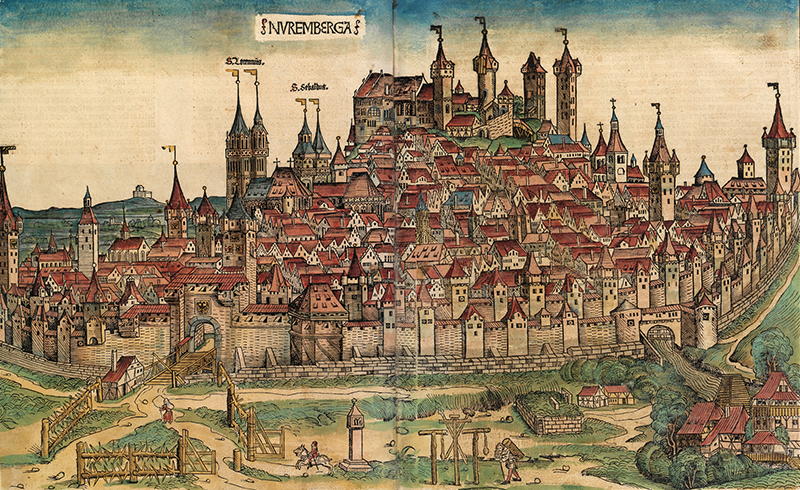
October 2, 2019
All Is Illusion: Music from Wagner’s Die Meistersinger von Nürnberg
On October 25, 26, and 27, world-renowned Wagner conductor Marek Janowski leads Wagner + Beethoven 2, a program of thrilling orchestral masterpieces by two of history’s most revolutionary composers. In this post, discover some of the moving and festive music Wagner composed for his opera Die Meistersinger von Nürnberg. Visit houstonsymphony.org for tickets and more information.

The idea for Die Meistersinger von Nürnberg (The Mastersingers of Nuremberg) first came to Wagner in 1845 when he read about the Meistergesang (mastersong) tradition of 16th century Germany; however, he would not seriously set to work on the opera until 1861, completing it in 1867. The eponymous mastersingers were amateur poet-musicians who cultivated a sophisticated style of song composition throughout the German renaissance era.
Set in the mastersingers’ Nuremberg, the opera centers on a burgeoning romance between Walther, an inspired but untutored singer, and Eva, the daughter one of Nuremberg’s mastersingers. He has determined that the winner of a song contest will inherit his wealth and win Eva’s hand in marriage (provided she consents), so Walther must discipline his natural talent by learning the intricate rules of the mastersingers’ musical style. After a failed attempt to impress the mastersingers, Walther and Eva plan to elope—forfeiting her father’s fortune and the acceptance of the community—but through a series of comic incidents their plans are foiled, and instead Walther seeks help from the kindly cobbler Hans Sachs, whose character was inspired by a real, historical mastersinger. With Sachs’s tutelage, Walther wins the contest, and all ends well.
Prelude to Act III
The Prelude to Act III occurs after Walther and Eva’s failed elopement, but before Walther turns to Sachs for music lessons. It has an arch-shaped ABCBA structure, beginning with a somber, quasi-fugal passage for strings:
Its main idea (introduced by the cellos), is known as the Wahn motif in the opera. The untranslatable German word “Wahn” encompasses madness, folly, delusion, and illusion. Near the beginning of Act III the motif plays a prominent role in Hans Sachs’ “Wahn monologue,” in which he meditates on the folly of human strife. In a letter to his patron, King Ludwig II of Bavaria, Wagner described it as “the bitter lament of the resigned man who shows the world a cheerful, energetic countenance,” a “cry from hidden depths.”
This pained music for strings is soon supplanted by horns and bassoons, who intone a melody in the style of a Lutheran chorale. In Act III, Scene V (the singing contest), the same melody is sung to the beginning of a poem written by the historical Hans Sachs:

Awake! the dawn is drawing near;
I hear a blissful nightingale
singing in the green grove,
its voice rings through hill and valley;
night is sinking in the west,
the day arises in the east,
the ardent red glow of morning
approaches through the gloomy clouds.
In the historical Sachs’ poem, the nightingale is Martin Luther, but in the opera, the townsfolk of Nuremberg sing the poem to honor the mastersinger Sachs himself.
This hopeful strain gives way to a more developmental passage based on fragments of the “Cobbling song,” which Sachs sings in Act II as Eva and Walter attempt to escape. The song tells how God took pity on Adam and Eve (Eva in German) when they fled paradise and sent an angel to make shoes for them so that they would not hurt their feet on the rocky earth. Sachs ends the song by saying that he himself would gladly give up the toil of cobbling shoes if it were not for an angel that called him to paradise. The message of patience and faith is not lost on the couple. Wagner wrote that when the Cobbling song reappears in the prelude, it is “as though the man were turning his gaze from his handiwork heavenwards and losing himself in tender reveries.”
After the reveries, the chorale resumes with new strength, but is suddenly interrupted by the return of the Wahn motif, “in a massive expression of the perturbation of a profoundly-stirred soul,” Wagner explains. “[F]inally, allayed and calmed, it attains the utmost cheerfulness of a benign and blissful resignation” as the prelude fades away.
Prelude to Act I
Though the Prelude to Act I begins the opera, many of its themes return at the opera’s jubilant conclusion; it thus follows the Act III prelude quite well. It begins with a grand theme associated with the proud mastersingers:
Wagner creates an atmosphere of long ago with contrapuntal textures—many independent voices that fit together simultaneously to create a harmonious whole—characteristic of renaissance and baroque music. A quieter transition features a motif in the woodwinds associated with Walther’s wooing of Eva, leading to a second grand theme in the brass: the mastersinger’s march. After an expressive passage in which a rising motif reaches ever upward, the music becomes quieter as we hear a series of yearning motifs associated with the young lovers, including what will become Walther’s winning Prize Song.

Commentator Ernest Newman has suggested that the following miniature version of the mastersinger’s march represents Nuremberg’s irreverent apprentices—mastersingers-in-training. Contrapuntal mischief ensues, but is soon swept aside by a return of the opening theme in the low strings and brass. A triangle then signals one of Wagner’s most ingenious orchestral passages: the first violins play the Prize Song melody while the other instruments simultaneously play the mastersingers’ opening and march themes. Ecstatic versions of the mastersinger themes then bring the prelude to a majestic ending. —Calvin Dotsey
Don’t miss music from Wagner’s Die Meistersinger von Nürnberg October 25, 26, and 27! Visit houstonsymphony.org for tickets and more information.






